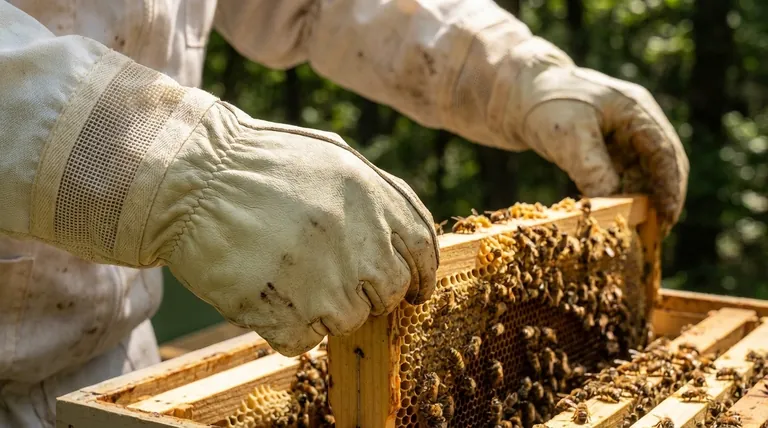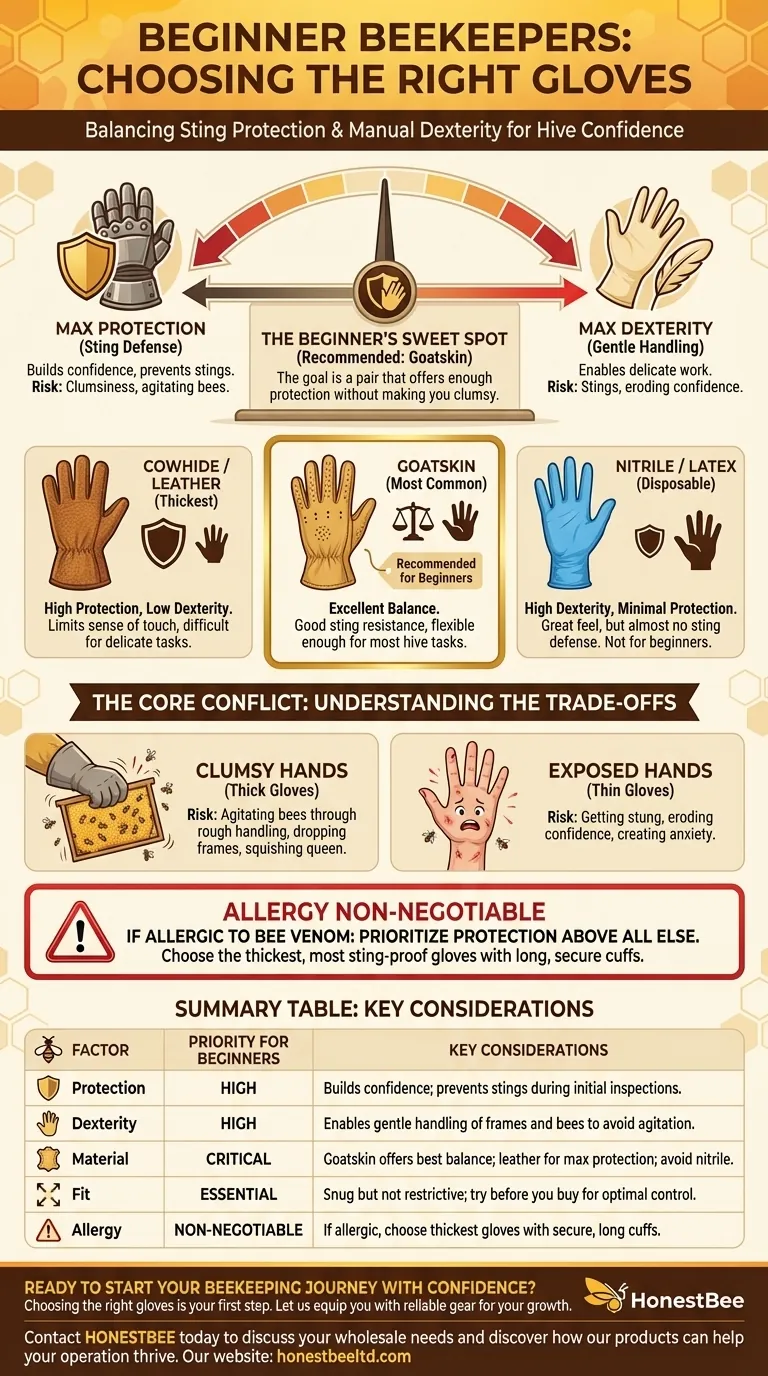For a beginner beekeeper, the best gloves offer a critical balance between sting protection and the dexterity needed to handle bees and equipment gently. While your instinct may be to get the thickest gloves possible, your primary goal is to find a pair, typically made of goatskin or leather, that provides enough protection to give you confidence without making you clumsy.
Your choice of beekeeping gloves is not about finding a single "best" option. It's about consciously managing the fundamental trade-off between physical protection and the manual dexterity required to be a calm, effective beekeeper.

The Core Conflict: Protection vs. Dexterity
Your first gloves are a tool for building confidence. Understanding the two opposing forces at play—protection and dexterity—is the key to choosing the right tool for the job.
Why Protection is the Priority for Beginners
As a beginner, your main goal is to get comfortable working inside a hive. Feeling secure from stings is essential for this.
Adequate protection allows you to move slowly and deliberately, focusing on observing your bees' behavior instead of worrying about getting stung. This confidence is your most important asset as you learn.
The Critical Role of Dexterity
While protection is key, you cannot be clumsy. Beekeeping requires surprisingly delicate work, like lifting individual frames or gently brushing bees aside.
Gloves that are too thick and bulky can cause you to make jerky movements, drop a frame, or even crush bees. These actions are far more likely to provoke a defensive reaction from the colony than the simple presence of your hands.
How Glove Material Dictates the Balance
Different materials offer different points on the protection-dexterity spectrum.
- Cowhide/Leather: These are often the thickest and offer maximum sting protection. However, they severely limit your sense of touch and dexterity, making delicate tasks difficult.
- Goatskin: This is the most common and recommended material for beginners. It offers an excellent balance, providing good sting resistance while remaining flexible enough for most hive tasks.
- Nitrile/Latex: These disposable gloves offer maximum dexterity and feel but provide almost no sting protection. They are used by some experienced beekeepers for quick tasks but are not suitable for a beginner's full hive inspection.
Understanding the Trade-offs
Every glove choice comes with a downside. Being aware of these limitations helps you make an informed decision and work more safely.
The Downside of Thick Gloves
The primary risk of thick, clumsy gloves is agitating your bees through rough handling. Dropping a frame of brood or squishing the queen because you couldn't feel what you were doing is a disaster that will set back your colony and your confidence.
The Risk of Thin Gloves
The obvious risk of thinner gloves is getting stung. For a beginner, a few stings can quickly erode confidence and make future inspections a source of anxiety rather than enjoyment.
The Allergy Non-Negotiable
This is the one area where there is no trade-off. If you are allergic to bee venom, you must prioritize protection above all else. Choose the thickest, most sting-proof gloves you can find and ensure they have long cuffs that seal securely to your bee suit.
Making the Right Choice for Your First Season
Your needs will change as you gain experience, but for now, focus on what will help you learn most effectively. Before buying, always try gloves on to ensure the fit is snug but not restrictive.
- If your primary focus is maximum safety and building initial confidence: Choose a quality pair of thick, ventilated leather or goatskin gloves.
- If your primary focus is balancing protection with developing good habits: A well-fitting, ventilated goatskin glove is the ideal starting point for most new beekeepers.
- If you know you have a bee venom allergy: Your only option is a pair of thick leather gloves with long, secure cuffs, prioritizing complete sting prevention.
Your first pair of gloves is a starting point, not a final decision, on your journey to becoming a competent and confident beekeeper.
Summary Table:
| Factor | Priority for Beginners | Key Considerations |
|---|---|---|
| Protection | High | Builds confidence; prevents stings during initial hive inspections. |
| Dexterity | High | Enables gentle handling of frames and bees to avoid agitation. |
| Material | Critical | Goatskin offers the best balance; leather for max protection; avoid nitrile. |
| Fit | Essential | Snug but not restrictive; try before you buy for optimal control. |
| Allergy | Non-Negotiable | If allergic, choose thickest gloves with secure, long cuffs. |
Ready to Start Your Beekeeping Journey with Confidence?
Choosing the right gloves is your first step toward becoming a successful beekeeper. At HONESTBEE, we specialize in supplying high-quality beekeeping supplies and equipment to commercial apiaries and distributors. We understand the precise balance of protection and dexterity needed for effective hive management.
Let us equip you with the reliable gear that supports your growth from beginner to expert.
Contact HONESTBEE today to discuss your wholesale needs and discover how our products can help your operation thrive.
Visual Guide

Related Products
- Goatskin Leather Beekeeper Gloves with Vent Long Sleeve for Beekeeping Honey Bee Sting Proof Protection
- Goat Skin Leather Bee Sting Proof Beekeeping Gloves with Canvas Sleeve
- Mesh Ventilated 3 Layer Goatskin Beekeepers Gloves for Beekeeping
- Professional Drop-Style Hive Handles for Beekeeping
- Professional Galvanized Hive Strap with Secure Locking Buckle for Beekeeping
People Also Ask
- What are the features of beekeeping gloves? Balancing Protection & Dexterity for Your Hives
- How do beekeeping gloves help in maintaining hygiene? Essential for Hive Biosecurity
- What should be considered when selecting beekeeping gloves? Find the Perfect Fit for Safety & Dexterity
- Which type of gloves provide the most sting resistance? The Definitive Guide to Beekeeping Hand Protection
- What is the importance of choosing the right gloves for beekeeping? Balance Protection and Dexterity for Hive Success



















